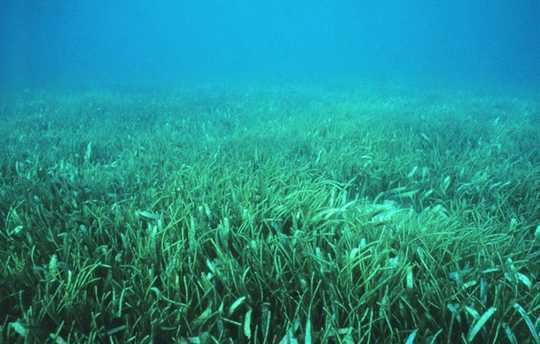
A seagrass meadow. For the first time, researchers have counted the greenhouse gases stored by and emitted from such ecosystems. NOAA/Heather Dine
It’s no secret that cutting down trees is a main driver of climate change. But a forgotten group of plants is critically important to fixing our climate — and they are being destroyed at an alarming rate.
Mangroves, tidal marshes and seagrasses along Australia’s coasts store huge amounts of greenhouse gases, known as blue carbon.
Our research, published in Nature Communications, shows that in Australia these ecosystems absorb 20 million tonnes of carbon dioxide each year. That’s about the same as 4 million cars.
Worryingly, the research shows that between 2 million and 3 million tonnes of carbon dioxide is released each year by the same ecosystems, due to damage from human activity, severe weather and climate change.
This research represents the world’s most comprehensive audit of any nation’s blue carbon. Around 10% of such ecosystems are located in Australia — so preserving and restoring them could go a long way to meeting our Paris climate goals.

A pile of washed-up seaweed and beach erosion at Collaroy Beach on Sydney’s northern beaches. Storms can damage blue carbon ecosystems. Megan Young/AAP
Super-charged carbon dioxide capture
Blue carbon ecosystems are vital in curbing greenhouse gas emissions. They account for 50% of carbon dioxide sequestered by oceans — despite covering just 0.2% of the world’s total ocean area — and absorb carbon dioxide up to 40 times faster than forests on land.
They do this by trapping particles from water and storing them in the soil. This means tidal marsh, mangrove and seagrass ecosystems bury organic carbon at an exceptionally high rate.
Globally, blue carbon ecosystems are being lost twice as fast as tropical rainforests despite covering a fraction of the area.
Since European settlement, about 25,000km² of tidal marsh and mangroves and 32,000km² of seagrass have been destroyed - up to half the original extent. Coastal development in Australia is causing further losses each year.
When these ecosystems are damaged — through storms, heatwaves, dredging or other human development — the carbon stored in biomass and soils can make its way back into the environment as carbon dioxide, contributing to climate change.
In Western Australia in the summer of 2010-11, about 1,000km² of seagrass meadows at Shark Bay were lost due to a marine heatwave. Similarly, two cyclones and several other impacts devastated a 400km stretch of mangroves in the Gulf of Carpentaria in recent years.

The beach and Cape Kimberley hinterland at the mouth of the Daintree River in Queensland. Brian Cassey/AAP
Such losses likely increase carbon dioxide emissions from land-use change in Australia by 12–21% per year.
Aside from the emissions reduction benefits, conserving and restoring blue carbon ecosystems would also increase the resilience of coasts to rising sea level and storm surge associated with climate change, and preserve habitats and nurseries for marine life.
How we measured blue carbon - and why
The project was part of a collaboration with CSIRO and included 44 researchers from 33 research institutions around the world.
To accurately quantify Australia’s blue carbon stocks, we divided Australia into five different climate zones. Variations in temperature, rainfall, tides, sediments and nutrients mean plant productivity and biomass varies across regions. So ecosystems in a tropical climate such as North Queensland store carbon dioxide at a different rate to those in temperate climates such as southeastern Australia.
We estimated carbon dioxide stored in the vegetation above ground and soils below for each climate area. We measured the size and distribution of vegetation and took soil core samples to create the most accurate measurements possible.
Blue carbon must be assessed on a national scale before policies to preserve them can be developed. These policies might involve replanting seagrass meadows, reintroducing tidal flow to restore mangroves or preventing potential losses caused by coastal development.

Seagrass at Queensland’s Gladstone Harbour. James Cook University
There’s a dollar to be made
Based on a carbon price of A$14 per tonne - the most recent price under the federal government’s Emissions Reduction Fund - blue carbon projects could be worth tens of millions of dollars per year in carbon credits. Our comprehensive measurements provide greater certainty of expected returns for financiers looking at investing in such projects.
Restoring just 10% of blue carbon ecosystems lost in Australia since European settlement could generate more than US$11 million per year in carbon credits. Conserving such ecosystems under threat could be worth between US$22 million and US$31 million per year.
Blue carbon projects cannot currently be counted towards Australia’s Paris targets, but federal environment authorities are developing a methodology for their inclusion. The reintroduction of tidal flow to restore mangrove and tidal marsh ecosystems has been identified as the most promising potential activity.
Other activities being explored include planning for sea level rise to allow mangrove and tidal marsh to migrate inland, and avoiding the clearing of seagrass and mangroves.
There are still questions to be answered about exactly how blue carbon can be used to mitigate climate change. But our research shows the massive potential in Australia, and allows other countries to use the work for their own blue carbon assessments.![]()
About The Authors
Oscar Serrano, ARC DECRA Fellow, Edith Cowan University; Carlos Duarte, Adjunct professor, King Abdullah University of Science and Technology; Catherine Lovelock, Professor of Biology, The University of Queensland; Paul Lavery, Professor of Marine Ecology, Edith Cowan University, and Trisha B Atwood, Assistant Professor of aquatic ecology, Utah State University
This article is republished from The Conversation under a Creative Commons license. Read the original article.
Related Books
Drawdown: The Most Comprehensive Plan Ever Proposed to Reverse Global Warming
by Paul Hawken and Tom Steyer In the face of widespread fear and apathy, an international coalition of researchers, professionals, and scientists have come together to offer a set of realistic and bold solutions to climate change. One hundred techniques and practices are described here—some are well known; some you may have never heard of. They range from clean energy to educating girls in lower-income countries to land use practices that pull carbon out of the air. The solutions exist, are economically viable, and communities throughout the world are currently enacting them with skill and determination. Available On Amazon
In the face of widespread fear and apathy, an international coalition of researchers, professionals, and scientists have come together to offer a set of realistic and bold solutions to climate change. One hundred techniques and practices are described here—some are well known; some you may have never heard of. They range from clean energy to educating girls in lower-income countries to land use practices that pull carbon out of the air. The solutions exist, are economically viable, and communities throughout the world are currently enacting them with skill and determination. Available On Amazon
Designing Climate Solutions: A Policy Guide for Low-Carbon Energy
by Hal Harvey, Robbie Orvis, Jeffrey Rissman With the effects of climate change already upon us, the need to cut global greenhouse gas emissions is nothing less than urgent. It’s a daunting challenge, but the technologies and strategies to meet it exist today. A small set of energy policies, designed and implemented well, can put us on the path to a low carbon future. Energy systems are large and complex, so energy policy must be focused and cost-effective. One-size-fits-all approaches simply won’t get the job done. Policymakers need a clear, comprehensive resource that outlines the energy policies that will have the biggest impact on our climate future, and describes how to design these policies well. Available On Amazon
With the effects of climate change already upon us, the need to cut global greenhouse gas emissions is nothing less than urgent. It’s a daunting challenge, but the technologies and strategies to meet it exist today. A small set of energy policies, designed and implemented well, can put us on the path to a low carbon future. Energy systems are large and complex, so energy policy must be focused and cost-effective. One-size-fits-all approaches simply won’t get the job done. Policymakers need a clear, comprehensive resource that outlines the energy policies that will have the biggest impact on our climate future, and describes how to design these policies well. Available On Amazon
This Changes Everything: Capitalism vs. The Climate
by Naomi Klein In This Changes Everything Naomi Klein argues that climate change isn’t just another issue to be neatly filed between taxes and health care. It’s an alarm that calls us to fix an economic system that is already failing us in many ways. Klein meticulously builds the case for how massively reducing our greenhouse emissions is our best chance to simultaneously reduce gaping inequalities, re-imagine our broken democracies, and rebuild our gutted local economies. She exposes the ideological desperation of the climate-change deniers, the messianic delusions of the would-be geoengineers, and the tragic defeatism of too many mainstream green initiatives. And she demonstrates precisely why the market has not—and cannot—fix the climate crisis but will instead make things worse, with ever more extreme and ecologically damaging extraction methods, accompanied by rampant disaster capitalism. Available On Amazon
In This Changes Everything Naomi Klein argues that climate change isn’t just another issue to be neatly filed between taxes and health care. It’s an alarm that calls us to fix an economic system that is already failing us in many ways. Klein meticulously builds the case for how massively reducing our greenhouse emissions is our best chance to simultaneously reduce gaping inequalities, re-imagine our broken democracies, and rebuild our gutted local economies. She exposes the ideological desperation of the climate-change deniers, the messianic delusions of the would-be geoengineers, and the tragic defeatism of too many mainstream green initiatives. And she demonstrates precisely why the market has not—and cannot—fix the climate crisis but will instead make things worse, with ever more extreme and ecologically damaging extraction methods, accompanied by rampant disaster capitalism. Available On Amazon
From The Publisher:
Purchases on Amazon go to defray the cost of bringing you InnerSelf.comelf.com, MightyNatural.com, and ClimateImpactNews.com at no cost and without advertisers that track your browsing habits. Even if you click on a link but don't buy these selected products, anything else you buy in that same visit on Amazon pays us a small commission. There is no additional cost to you, so please contribute to the effort. You can also use this link to use to Amazon at any time so you can help support our efforts.






















